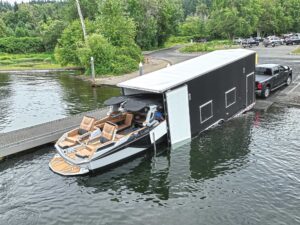Nothing in your nautical experience goes as unappreciated as the motor on your tender. After all, you use it only to get from the dock to your mooring, and vice versa. But there are a lot of factors to consider when shopping for that little powerplant, including size, weight, and ease of use.
We tested the smallest engine offered by each company on a 9′ Walker Bay RID rated for up to 4 hp. We evaluated each one for ease of handling and operation. We ran them on a protected creek with two adults aboard, total weight of around 350 pounds. Which is the best motor? We found good things to say about all of them, but there can be only one winner. Here are our results.
Tohatsu 2.5 Two-Stroke ($630; www.tohatsu.com) power: 2.5 hp weight: 26 pounds top speed: 5.4 mph noise at full throttle: 84 dB-A. The Tohatsu 2.5 was the only two-stroke we tested. As expected, it’s the lightest and least expensive. But you have to mix the gas and oil. It was easy to mount and started quickly. There’s no shifting, which means when you start, you’re in gear and on the move. The T-shaped sliding-knob throttle advance on the face of the motor means you need two hands-one to steer and one to change speed. Mercury also offers a 2.5-hp two-stroke engine, the 2.5 Classic ($704; www.mercurymarine.com), which is identical to the Tohatsu except for the black cowling.
Suzuki DF-4 Four-Stroke ($1,190; www.suzuki.com) power: 4 hp weight: 60 pounds top speed: 6.0 mph noise at full throttle: 90 dB-A. This machine has some outstanding features, including a forward, neutral, and reverse shifter, and three shallow-water lift settings. These are offset by its heft, which makes it hard to mount on the transom in anything but calm conditions. Surprisingly quiet and vibration-free, the Suzuki DF-4 left us with the feeling that there was some unused power that could be harnessed with the right combination of prop, motor settings, and dinghy balance. Johnson markets the identical Suzuki motor under its own name but uses a different cowling ($1,610; www.johnson.com).
Honda BF2 Four-Stroke ($920; www.honda-marine.com) power: 2 hp weight: 29 pounds top speed: 5.3 mph noise at full throttle: 95 dB-A. The Honda BF2 employs a centrifugal clutch, which allows the engine to idle without moving the boat and automatically engages the prop as the RPM rises. For reverse, it rotates a full 360 degrees. It’s the lightest four-stroke we tested. It’s easy to handle and has convenient grab points for lifting.
Yamaha F2.5 Four-Stroke ($940; www.yamaha-motor.com) power: 2.5 hp weight: 38 pounds top speed: 5.4 mph noise at full throttle: 87 dB-A. The F2.5 starts in neutral and has a forward gearshift. For reverse, the motor has to be turned around, but it doesn’t spin a full 360 degrees, which prevents true reverse. Mounting and removing were awkward since the back grabhandle is located too far below the top, and there’s no handle on the front.
And the Winner Is… At this size, neither four-stroke nor two-stroke has an advantage over the other, nor do more horses equate to significantly higher speeds. Four-strokes negate the need to mix in gas and oil, a convenience factor in their favor. But their extra heft makes them harder to handle. Plus, they’re more expensive. But there’s one lightweight, relatively inexpensive four-stroke in the bunch. The Honda BF2 weighs only 29 pounds, is easy to handle, has a decent sticker price, and boasts simple, hassle-free features. For that, we’d choose the Honda to power our dinghy.









